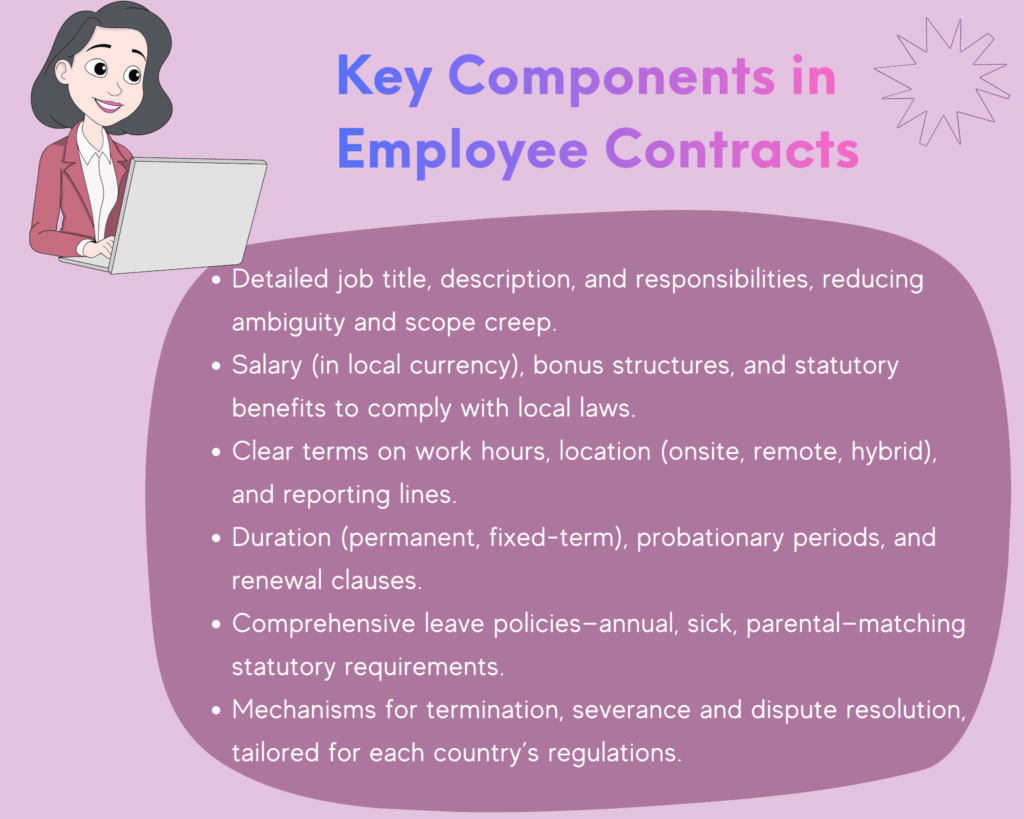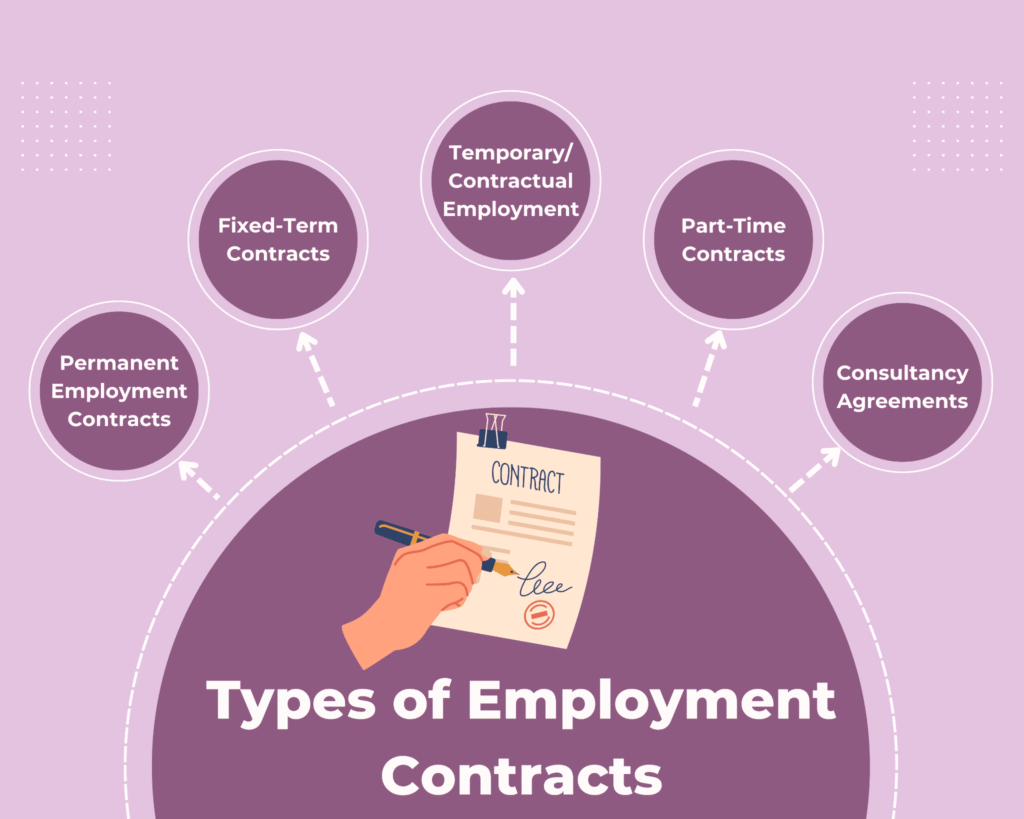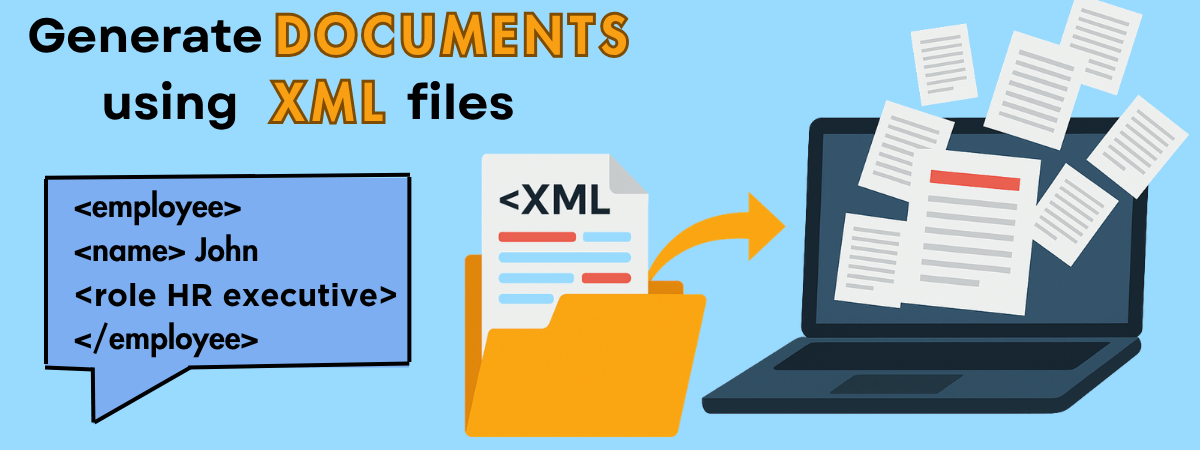The Complete Guide to Employee Contracts: Everything You Need to Know in 2026

Employee Contracts are absolutely crucial to any employer-employee relationship. It not only protects the employer from potential disputes but also ensures employees are guaranteed fair treatment. A relationship built on such a foundation is necessary, even if it’s a company of just 10 employees or a large-scale organization.
Most big companies already churn out standardized contracts that they replace with personal details, designation, and salary. However, the ones struggling would be small and medium-sized organizations. This guide will give you a comprehensive understanding of employee agreements, their components, types, best practices, and common mistakes or overlooked elements that might come back to bite you.
Key Takeaways:
● Employee contracts are essential for protecting both parties: employees and employers. They should be tailored based on the role and contract type.
● Comprehensive employee contracts include plain and clear responsibilities, compensation, leave policies, probation, confidentiality, IP rights, termination terms, and overlooked clauses like remote work, mental health, and data privacy.
● There are different contract types: permanent, fixed-term, temporary, part-time, and consultancy, each with distinct legal and operational implications.
● Perfect Doc Studio simplifies contract creation with an intuitive interface, a vast template library, seamless negotiations, automated workflows, compliance management, multilanguage support, and built-in reporting.
● Digitization and automation of employee contracts saves HR teams time, reduces risk, ensures compliance, and improves employee trust through clear, precise contracts.
What Needs to Be in an Employee Contract in 2026?
A good employee contract doesn’t just include the role’s responsibilities, basic job details, conditions of their employment, and benefits.

In this day and age, it is so much more. There are different types of contracts, and each type comes with conditions more suitable for it. We’ll examine the various types, but first, let’s explore the nuances of employee contracts best practices.
Job Information and Responsibilities
Any employee contract must define the employee’s job title, department assignment, reporting structure, and primary responsibilities. The descriptions have to be precise and nothing vague that might open the door to legal loopholes and disputes. It is best to mention specific duties with key performance indicators and evaluation criteria that set clear expectations from the get-go.
Compensation and Benefits
Employees value transparency in compensation, which helps prevent misunderstandings during their tenure. An employee contract should detail the complete salary structure, including basic pay, performance-based incentives, bonuses, statutory benefits, and additional benefits (health insurance, meal allowances, and retirement plans). Make sure to specify the payment schedule and method to ensure employees know exactly when and how they’ll be compensated.
Working Hours and Leave Policies
With flexible hours and remote work, it is absolutely pivotal for organizations to establish standard working hours for each role. The employment contract should define overtime policies, annual leave entitlement, sick leave provisions, public holidays, and special leaves (bereavement, marriage, and parental leave).
Probation Period
A probationary period is standard all over the world, while some organizations have a longer period for specialized roles. A contract should specify the duration, performance evaluation criteria and frequency, confirmation process upon successful completion, conditions for extension (if applicable), and terms for early termination during probation.
Confidentiality and Non-Disclosure
Poaching employees has become quite common these days; organizations have the onus to protect their business’s sensitive information. Including clear definitions of what constitutes confidential information, obligations during and after employment, exceptions to confidentiality requirements, and consequences of breach would save you from strategic information ending up with your competitors or third parties.
Intellectual Property Rights
This is one of the most overlooked clauses for many small and medium businesses. A comprehensive contract would specify who owns IP created during employment. It must define what constitutes a work-related IP and what is considered a personal project. To ensure fairness, it should also include compensation terms for exceptional innovations.
Termination Clauses
A contract that is well drafted protects both parties by outlining notice periods, grounds for termination, severance provisions, post-termination obligations, and return of company property. This ensures reduced legal risks and disputes that would damage the brand and incur unnecessary legal fees.
Your needs go beyond contracts? Check out our insights into the best legal document generation tools in the market.
Types of Employment Contracts
There are various types of contracts, and each one stipulates different terms and arrangements for a specific role. For instance, a part-time employee and a full-time employee would have different content on their contracts even if the designation is the same.

Permanent Employee Contract
The most common type is this one, as most companies hire full-time employees. Such agreements don’t have a fixed end date and offer job security with the maximum benefits that a company can offer.
Ideal for core positions requiring long-term commitment and typically include comprehensive benefit packages, statutory protections, and clear career progression paths.
Fixed Term Contracts
These contracts specify a clear start and end date, hence the name. Many countries’ laws stipulate that such employment also necessitates the same benefits and compensation as permanent employees on a pro-rata basis.
Ideal for organizations hiring for project-based work or just temporary replacements. There is a possibility that such term contracts can be converted into full-time employment, and possibilities of potential offers of full-time employment can be included as well.
Temporary or Contractual Employment
Often initiated through third-party agencies, these employees may not get benefits from the organization itself but would be getting paid by the third-party agency, unless explicitly stated in the agreement.
Ideal for short durations or seasonal work. For instance, temp employees are hired when full-time employees go on maternity leave or during seasonal rush periods.
Part-Time Contracts
Part-time work, as the name suggests, is quite common in many companies all around the world. They offer flexibility but have limited benefits; in many cases, they offer no benefits at all.
Ideal for organizations requiring employees for a limited time period or with specific expertise. These specifically cater to those working no more than 40 hours per week.
Consultancy Agreements
Specifically designed for independent professionals, offering flexibility for both parties. They provide minimal job security, and their employment is based on deliverables rather than hours worked.
Ideal for organizations looking for consultants in particular fields that are not typically required all year round. The payment, as well, is for completed work, and employees work only when needed.
Want to create more than just employee contracts? Here is a complete guide to the Top 5 Contract Automation Tools: Features & Pricing
Typical Aspects Overlooked in Employment Contracts
While most big organizations cover everything, small or medium-sized businesses sometimes fail to be comprehensive. These, of course, wouldn’t lead to disputes, but may strain the employer-employee relationship.
Employee Contract Clauses that Include Remote Work Provisions (2026 Essentials)
Since the pandemic, remote work has become the norm, with employees now expecting this flexibility. Likewise, employee contracts should address location flexibility, for instance, employees can work from anywhere or must stay within specific regions, and how this will be monitored. Then comes the remote work necessities: internet speed requirements and technology standards, equipment provision and responsibility, expense reimbursements for home office setup, virtual meeting platform requirements, and cybersecurity protocols for home networks.
Why Include Mental Health and Wellness Clauses
The past decade has experienced a drastic shift in the awareness of mental health, work-life balance, and employees now include mental health provisions in employment contracts. Companies that care about their employees’ mental well-being offer EAP (Employee Assistance Programs), offering access to counseling services and stress management programs, mental health days included in the leave policy, and providing flexible work arrangements for mental health management.
Adhering to Data Privacy and GDPR Compliance in Employee Agreements
With increasing global data protection regulations and customers’ awareness of data privacy, employee contracts should include explicit data protection clauses. A well-drafted contract would not only specify what employee data will be collected and processed, but also cover how employees should handle organizational and client data.
Social Media and Digital Conduct Policies
A slightly controversial point, but many companies feel that an employee’s social media conduct impacts the organization’s reputation and standing. Modern contracts should address the expectations that employers have for an employee’s social media behavior, especially regarding company representation, the consequences of posting confidential information, guidelines for distinguishing between personal and professional accounts, and protocols for company-related online communications.
Continuous Learning and Development Initiatives
Employers can include clauses about professional development opportunities, training reimbursement policies, conference attendance provisions, and expectations for skill development. Especially if the role dictates potential learning and development opportunities, this ensures organizations protect their training investment as well.
Practical Tips and Best Practices for Drafting Employee Contracts
Avoid One-Size-Fits-All Templates: We understand that it’s easier to have one standard template and use it for different contract types, sometimes even different designations. However, it’s wise to have customized contracts for specific roles, industry requirements, and seniority levels. Generic contracts only open you up to compliance gaps and fail to address role-specific needs. It’s simply easier to create a template for different roles and industries and tailor it based on seniority levels and contract type.
Use Simple, Jargon-Free Language: As a rule of thumb, use plain, straightforward language, avoiding ambiguous language. If both parties can understand the contract without legal dictionaries, it is better. Only use technical terms that are necessary and mention clear definitions when doing so.
Balance Protection with Fairness: While employment contracts are made to protect company interests, they cannot be too restrictive. Avoid unreasonable clauses or excessive restrictions that unfairly limit employee opportunities.
Regular Reviews and Updates: Employee laws are constantly changing, and HRs must review contract templates annually to ensure compliance with new regulations or labour laws.
Allow sufficient Review Time: Give employees adequate time to review contracts before they sign anything. Remember, you’re getting it in writing, so you should encourage them to ask questions. This demonstrates good faith and reduces claims of coercion.
Include Modification Procedures: Specify how contract amendments will be handled. For instance, organizations cannot unilaterally change the terms without employee consent and establish a clear process for mutual agreement on modifications.
Maintain Proper Documentation: Keep all signed copies of all employment contracts with acknowledgements and receipts. Having a digital contract management system makes this process easier and more efficient than storing physical documents in cabinets.
Perfect Doc Studio Can Transform Your Employee Contract Process
Perfect Doc Studio is a contract generation and automation tool that helps small and medium-sized businesses draft, execute, and manage employee contracts and contract templates. With a user-friendly, drag-and-drop interface, Perfect Doc Studio is the ideal business-friendly tool that can help HRs and organizations with their employee contract creation needs. Here are
Template-Based Document Generation: Perfect Doc Studio empowers HR teams to design and deliver personalized employment contracts without IT involvement. The platform goes beyond the Microsoft Word processor, using a drag-and-drop interface on a blank canvas..
You can include pre-approved headers, footers, dynamic images, and even integrate with e-signature platforms.
Template Library: A user just has to create a template, reusable sections like Headers, Footers, Governing Law and Jurisdiction, Severability Clause, and others. Likewise, reusable sections like Confidentiality and Non-Disclosure, Compensation and Benefits, Termination and Notice Periods, and more.
These just need to be created and can be added to different documents by simply adding them. All these templates are stored in the vast template library that is legally vetted and automatically updates to match regulatory standards.
Seamless Integrations: The system’s native integration engine connects with any application, system, or data source, and once an input is made in Workday, Salesforce, or Rippling, the data is automatically retrieved.
A document is created based on the template assigned for that role or designation. Dynamic elements can be used to auto-populate contracts from CRMs, HRIS, or Payroll data
Automated Workflows: The automated workflows work seamlessly to move directly from drafting to approval and e-signatures, with integrated compliance tracking.
Workflow orchestrates your entire contract process when triggered. If you are scaling your organization, PDS offers powerful batch processing capabilities.
Compliance Management Built-in: The platform maintains audit trails, accurate records, and versioning, ensuring you adhere to governing laws and regulations.
The platform is GDPR compliance and offers enterprise-grade security at a fraction of the cost, making it suitable for businesses of all sizes.
Multilanguage Support: Perfect Doc Studio supports document creation in over 100 languages, allowing you to localize all your employee contracts and communications. It is equipped with over 1,200 professional fonts, various page sizes from A0 to A6 and US legal, and customizable layouts for professional presentations.
This is ideal for organizations with multicultural teams. With PDS, every team member will have a clear understanding of their employment terms, regardless of their preferred language.
Automated Reporting and Analytics: The platform has dashboards that track metrics and generate insights on contract volume, template usage, approval bottlenecks, and compliance gaps.
HR teams can use this data to optimize processes and forecast hiring needs.
Perfect Doc Studio can be an HR’s new best friend. Sign up now for a lifetime freemium account!
Building Strong Foundations With Comprehensive Employee Contracts
Employee contracts are the foundation of the employee-employer relationship, including all essential components. By choosing the right contract type and addressing overlooked aspects like remote work, HR teams can create agreements that align with organizational needs and protect employee rights.
Employment contracts are constantly evolving, with data privacy rules, work classifications, regulatory requirements, and the digitization and usage of compliance-friendly tools is invaluable. Perfect Doc Studio empowers organizations to create comprehensive, compliant employee contracts with speed, ease, and efficiency like never before. It also reduces time and resources that would otherwise be spent on contract management.
Whether you’re a small organization just starting out and hiring your first employee or a large-scale organization hiring your thousandth employee, investing in employee contacts and the right tools to manage them benefits you. It can help reduce disputes, improve employee satisfaction, and provide stronger legal protection.
FAQs
A comprehensive employee contract should define job responsibilities, compensation details, leave policies, probation terms, confidentiality, intellectual property rights, termination procedures, and modern clauses addressing remote work, mental health, and data privacy compliance.
The primary types include permanent contracts for long-term roles, fixed-term contracts for projects, temporary contractual employment, part-time agreements, and consultancy contracts for independent professionals.
Small businesses can leverage contract automation tools like Perfect Doc Studio, which offers customizable templates, workflow automation, compliance management, and multi-language support to streamline contract creation without legal expertise.
Labor laws and employment standards evolve continuously, so regular contract reviews help companies avoid compliance breaches, accommodate new work models, and reduce legal disputes.
Perfect Doc Studio enables HR teams to design, automate, and manage contracts using drag-and-drop templates, dynamic data integration, workflow automation, compliance tracking, and multi-language support—all improving speed, accuracy, and legal safety.
Top Customer Communication Management(CCM) Trends in 2025
The blog outlines key trends in Customer Communication Management (CCM) for 2025, highlighting the m
How to Generate Documents with XML Files
This blog offers a practical guide to generating documents using XML files using various methods. We




